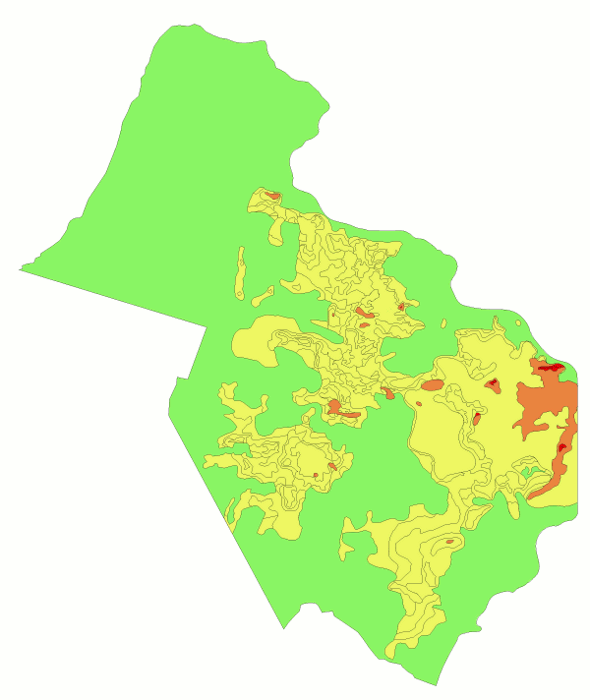What It Means For Sprawl

Given the current land use policies and the number of MF and TH developments being created vs the number of suburban and exurban units being created there is a large likelihood that the sprawl expansion of Northern Virginia will be unimpeded if not accelerated. The amount of space that a single family housing unit requires is nearly 5 times more than an equivalent townhome, and 100 times more than an equivalent multi-family dwelling.
SFH sprawl will eat up 440 million square feet of rural lands every year given the current population growth trends of our area if the mix of annual construction remains 25% MF, 24% TH, 51% SFH. To the right is a demonstration of what this growth will mean between today and 2030. As can be seen development of Loudoun will expand into western Loudoun and the Leesburg region, something that most current Western Loudoun residents are against. Unfortunately, no matter the conditions put on land developers, given these market conditions the expansion is essentially unstoppable. The market conditions themselves must be addressed to provide other options in core regions.
Rural areas north of Gainesville will ultimately combine with sprawl along Route 50 near South Riding creating some serious gridlock for Route 50 and I-66. Woodbridge will continue to expand into preserved lands, much of which contains natural habitats for bald eagles as well as our colonial heritage.

Essentially, there is no room to build anywhere closer in when you are talking about single family housing only. Fairfax has very little open developable areas remaining, especially at the scale of 11,500 SFH needed per year.
What Solutions Are Possible?
The key is that there is currently a deficiency in dwelling mix. The argument that younger residents will live in DC or Maryland doesn’t hold water because there are already 50,000 residents choosing to live in DC and Maryland annually, and still 45,000 residents are anticipated to choose Northern Virginia as their home. Residents want Fairfax because of better schools, safer neighborhoods, and because Fairfax is where their job is. There simply is no way to stop all growth in Northern Virginia without a reduction in our regional economic growth.

If the dwelling construction mix was shifted to 35% MF, 35% TH, and 30% Single Family Housing construction in this area would not reach an equilibrium in the current dwelling mix deficiency until 2030. During that time our population will grow nearly 800,000 residents and will likely be plateauing by 2030, or shifting towards a secondary urban region outside of Washington DC (drawing a different age of resident to urban regions of Arlington and Fairfax). With this mix of construction the incursion on rural areas will be reduced from 440 million square feet per year to 270 million square feet per year, a reduction of almost 40% in outer expansion. That results in significant cost savings in infrastructure as well as a reduction in future congestion on major corridors.

If the dwelling construction mix was shifted to 50% MF, 40% TH, and 10% Single Family Housing construction in this area would not reach an equilibrium in the current dwelling mix deficiency until 2025 (approximately 580,000 of the 800,000 anticipated new residents). With this mix of construction the incursion on rural areas will be reduced from 440 million square feet per year to 100 million square feet per year until 2025, a reduction of almost 80% in outer expansion.
These changes in growth types show that the continued expansion of suburbs into rural areas in Western Loudoun and Prince William County are actually in large part caused by a deficiency in dwelling types in Fairfax. By simply providing more high-rises and townhomes in existing parts of Fairfax this sprawl expansion could be significantly slowed.
Benefits of Stopping Sprawl
Allowing this growth outward means a worst case scenario for Fairfax. Congestion and infrastructure costs would increase exponentially, while revenue from real estate taxes would grow at only 3-4% per year. Major expansions would be necessary on Route 50, Route 7, Route 1, I-495, I-395, I-66, Fairfax County Parkway, Braddock Road, and Route 28. These costs mean billions in expenses because of where new growth will be occurring.
If the 50-40-10 model were to be used only 10% of new growth would occur in outer suburbs, while 90% of the growth would be occurring in existing neighborhoods with high-volume transit and infrastructure in place. Instead of 15,000 new residents using major thoroughfares every year (270,000 by 2030), this would be reduced to 2,500 new residents using major thoroughfares every year (45,000 by 2030).
The point of smart growth isn’t to force people to live in housing units that don’t make sense. It is to provide a balanced approach to housing and zoning so that cheap land in outer regions is not continuously the relief valve for a regions growth. There is a very large population of current residents who would live in Fairfax and inner suburbs if a supply of units was available. Development is never a zero-base situation. By fighting against urbanization in feasible areas like Arlington, Tysons, and Alexandria, more market pressure continues to mean sprawl outward.
| Page | 1 |
